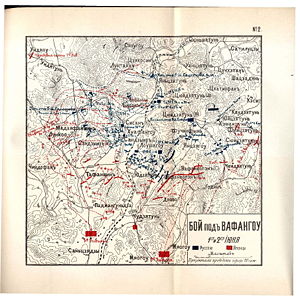Battle of Telissu
| Battle of Telissu | |||||||
|---|---|---|---|---|---|---|---|
| Part of the Russo-Japanese War | |||||||
 Battle of Telissu map |
|||||||
|
|||||||
| Belligerents | |||||||
|
|
|
||||||
| Commanders and leaders | |||||||
| General Oku Yasukata | Lieutenant-General Georgii Stackelberg | ||||||
| Strength | |||||||
| 40,000 | 35,000-50,000 | ||||||
| Casualties and losses | |||||||
| 217 killed 946 wounded |
2,000-5,000 killed and wounded 665 missing |
||||||
The Battle of Te-li-ssu (得利寺の戦い Tokuriji no tatakai), also called Battle of Wafangou (Russian: Бой у Вафангоу) after the nearby railway station, was a land battle of the Russo-Japanese War. It was fought at a hamlet some 80 mi (130 km) north of Port Arthur, Manchuria. The hamlet is known today as Delisi, and is located just north of Wafangdian, Liaoning Province, China. It was fought on 14–15 June 1904 between the Japanese Second Army under General Oku Yasukata and the Russian First Siberian Army Corps under Lieutenant General Georgii Stackelberg.
After the loss to the Japanese at the Battle of Nanshan, the Russian Viceroy Yevgeni Alekseyev came under extreme political pressure to make a military advance to prevent the complete encirclement of Port Arthur. The Commander-in-Chief of the Imperial Russian Army in Manchuria, General Alexei Kuropatkin, disagreed vehemently to this plan, which he felt to be both foolhardy and dangerous, and he preferred to wait in Mukden for the Trans-Siberian Railway to bring him the reinforcements he felt necessary for an offensive. The matter came to head on 27 May 1904, when Viceroy Alexeiev summoned General Kuropatkin to a conference in Mukden. The two men wound up shouting at each other, and the matter was referred to St. Petersburg for a decision. The Tsar decided in favor of the Viceroy, and General Kuropatkin was reluctantly forced to mount an offensive from Liaoyang in the general direction of Port Arthur, but it is clear that he had no expectation of reaching that port. Lieutenant-General Georgii Stakelberg commanding 27,000 infantry, 2,500 cavalry (under the command of Lieutenant General Simonov) and 98 guns in the First Siberian Corps, was chosen for the mission. They were later supplemented by 3,000 riflemen and two guns, which arrived just as the frontline troops were withdrawing.
...
Wikipedia
